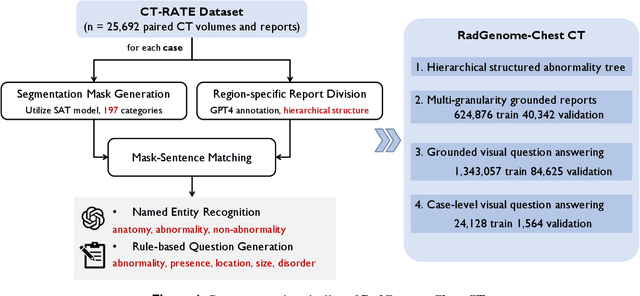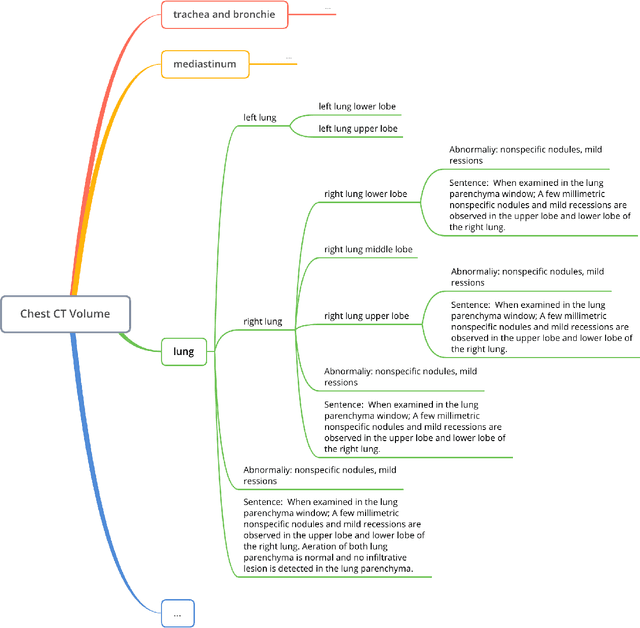Xiaoman Zhang
FactCheXcker: Mitigating Measurement Hallucinations in Chest X-ray Report Generation Models
Nov 27, 2024



Abstract:Medical vision-language model models often struggle with generating accurate quantitative measurements in radiology reports, leading to hallucinations that undermine clinical reliability. We introduce FactCheXcker, a modular framework that de-hallucinates radiology report measurements by leveraging an improved query-code-update paradigm. Specifically, FactCheXcker employs specialized modules and the code generation capabilities of large language models to solve measurement queries generated based on the original report. After extracting measurable findings, the results are incorporated into an updated report. We evaluate FactCheXcker on endotracheal tube placement, which accounts for an average of 78% of report measurements, using the MIMIC-CXR dataset and 11 medical report-generation models. Our results show that FactCheXcker significantly reduces hallucinations, improves measurement precision, and maintains the quality of the original reports. Specifically, FactCheXcker improves the performance of all 11 models and achieves an average improvement of 94.0% in reducing measurement hallucinations measured by mean absolute error.
ReXrank: A Public Leaderboard for AI-Powered Radiology Report Generation
Nov 22, 2024



Abstract:AI-driven models have demonstrated significant potential in automating radiology report generation for chest X-rays. However, there is no standardized benchmark for objectively evaluating their performance. To address this, we present ReXrank, https://rexrank.ai, a public leaderboard and challenge for assessing AI-powered radiology report generation. Our framework incorporates ReXGradient, the largest test dataset consisting of 10,000 studies, and three public datasets (MIMIC-CXR, IU-Xray, CheXpert Plus) for report generation assessment. ReXrank employs 8 evaluation metrics and separately assesses models capable of generating only findings sections and those providing both findings and impressions sections. By providing this standardized evaluation framework, ReXrank enables meaningful comparisons of model performance and offers crucial insights into their robustness across diverse clinical settings. Beyond its current focus on chest X-rays, ReXrank's framework sets the stage for comprehensive evaluation of automated reporting across the full spectrum of medical imaging.
ReXplain: Translating Radiology into Patient-Friendly Video Reports
Oct 01, 2024Abstract:Radiology reports often remain incomprehensible to patients, undermining patient-centered care. We present ReXplain (Radiology eXplanation), an innovative AI-driven system that generates patient-friendly video reports for radiology findings. ReXplain uniquely integrates a large language model for text simplification, an image segmentation model for anatomical region identification, and an avatar generation tool, producing comprehensive explanations with plain language, highlighted imagery, and 3D organ renderings. Our proof-of-concept study with five board-certified radiologists indicates that ReXplain could accurately deliver radiological information and effectively simulate one-on-one consultations. This work demonstrates a new paradigm in AI-assisted medical communication, potentially improving patient engagement and satisfaction in radiology care, and opens new avenues for research in multimodal medical communication.
Uncovering Knowledge Gaps in Radiology Report Generation Models through Knowledge Graphs
Aug 26, 2024Abstract:Recent advancements in artificial intelligence have significantly improved the automatic generation of radiology reports. However, existing evaluation methods fail to reveal the models' understanding of radiological images and their capacity to achieve human-level granularity in descriptions. To bridge this gap, we introduce a system, named ReXKG, which extracts structured information from processed reports to construct a comprehensive radiology knowledge graph. We then propose three metrics to evaluate the similarity of nodes (ReXKG-NSC), distribution of edges (ReXKG-AMS), and coverage of subgraphs (ReXKG-SCS) across various knowledge graphs. We conduct an in-depth comparative analysis of AI-generated and human-written radiology reports, assessing the performance of both specialist and generalist models. Our study provides a deeper understanding of the capabilities and limitations of current AI models in radiology report generation, offering valuable insights for improving model performance and clinical applicability.
AutoRG-Brain: Grounded Report Generation for Brain MRI
Jul 26, 2024Abstract:Radiologists are tasked with interpreting a large number of images in a daily base, with the responsibility of generating corresponding reports. This demanding workload elevates the risk of human error, potentially leading to treatment delays, increased healthcare costs, revenue loss, and operational inefficiencies. To address these challenges, we initiate a series of work on grounded Automatic Report Generation (AutoRG), starting from the brain MRI interpretation system, which supports the delineation of brain structures, the localization of anomalies, and the generation of well-organized findings. We make contributions from the following aspects, first, on dataset construction, we release a comprehensive dataset encompassing segmentation masks of anomaly regions and manually authored reports, termed as RadGenome-Brain MRI. This data resource is intended to catalyze ongoing research and development in the field of AI-assisted report generation systems. Second, on system design, we propose AutoRG-Brain, the first brain MRI report generation system with pixel-level grounded visual clues. Third, for evaluation, we conduct quantitative assessments and human evaluations of brain structure segmentation, anomaly localization, and report generation tasks to provide evidence of its reliability and accuracy. This system has been integrated into real clinical scenarios, where radiologists were instructed to write reports based on our generated findings and anomaly segmentation masks. The results demonstrate that our system enhances the report-writing skills of junior doctors, aligning their performance more closely with senior doctors, thereby boosting overall productivity.
RaTEScore: A Metric for Radiology Report Generation
Jun 24, 2024Abstract:This paper introduces a novel, entity-aware metric, termed as Radiological Report (Text) Evaluation (RaTEScore), to assess the quality of medical reports generated by AI models. RaTEScore emphasizes crucial medical entities such as diagnostic outcomes and anatomical details, and is robust against complex medical synonyms and sensitive to negation expressions. Technically, we developed a comprehensive medical NER dataset, RaTE-NER, and trained an NER model specifically for this purpose. This model enables the decomposition of complex radiological reports into constituent medical entities. The metric itself is derived by comparing the similarity of entity embeddings, obtained from a language model, based on their types and relevance to clinical significance. Our evaluations demonstrate that RaTEScore aligns more closely with human preference than existing metrics, validated both on established public benchmarks and our newly proposed RaTE-Eval benchmark.
RadGenome-Chest CT: A Grounded Vision-Language Dataset for Chest CT Analysis
Apr 25, 2024



Abstract:Developing generalist foundation model has recently attracted tremendous attention among researchers in the field of AI for Medicine (AI4Medicine). A pivotal insight in developing these models is their reliance on dataset scaling, which emphasizes the requirements on developing open-source medical image datasets that incorporate diverse supervision signals across various imaging modalities. In this paper, we introduce RadGenome-Chest CT, a comprehensive, large-scale, region-guided 3D chest CT interpretation dataset based on CT-RATE. Specifically, we leverage the latest powerful universal segmentation and large language models, to extend the original datasets (over 25,692 non-contrast 3D chest CT volume and reports from 20,000 patients) from the following aspects: (i) organ-level segmentation masks covering 197 categories, which provide intermediate reasoning visual clues for interpretation; (ii) 665 K multi-granularity grounded reports, where each sentence of the report is linked to the corresponding anatomical region of CT volume in the form of a segmentation mask; (iii) 1.3 M grounded VQA pairs, where questions and answers are all linked with reference segmentation masks, enabling models to associate visual evidence with textual explanations. All grounded reports and VQA pairs in the validation set have gone through manual verification to ensure dataset quality. We believe that RadGenome-Chest CT can significantly advance the development of multimodal medical foundation models, by training to generate texts based on given segmentation regions, which is unattainable with previous relevant datasets. We will release all segmentation masks, grounded reports, and VQA pairs to facilitate further research and development in this field.
Knowledge-enhanced Visual-Language Pretraining for Computational Pathology
Apr 15, 2024



Abstract:In this paper, we consider the problem of visual representation learning for computational pathology, by exploiting large-scale image-text pairs gathered from public resources, along with the domain specific knowledge in pathology. Specifically, we make the following contributions: (i) We curate a pathology knowledge tree that consists of 50,470 informative attributes for 4,718 diseases requiring pathology diagnosis from 32 human tissues. To our knowledge, this is the first comprehensive structured pathology knowledge base; (ii) We develop a knowledge-enhanced visual-language pretraining approach, where we first project pathology-specific knowledge into latent embedding space via language model, and use it to guide the visual representation learning; (iii) We conduct thorough experiments to validate the effectiveness of our proposed components, demonstrating significant performance improvement on various downstream tasks, including cross-modal retrieval, zero-shot classification on pathology patches, and zero-shot tumor subtyping on whole slide images (WSIs). All codes, models and the pathology knowledge tree will be released to the research community
Towards Building Multilingual Language Model for Medicine
Feb 26, 2024



Abstract:In this paper, we aim to develop an open-source, multilingual language model for medicine, that the benefits a wider, linguistically diverse audience from different regions. In general, we present the contribution from the following aspects: first, for multilingual medical-specific adaptation, we construct a new multilingual medical corpus, that contains approximately 25.5B tokens encompassing 6 main languages, termed as MMedC, that enables auto-regressive training for existing general LLMs. second, to monitor the development of multilingual LLMs in medicine, we propose a new multilingual medical multi-choice question-answering benchmark with rationale, termed as MMedBench; third, we have assessed a number of popular, opensource large language models (LLMs) on our benchmark, along with those further auto-regressive trained on MMedC, as a result, our final model, termed as MMedLM 2, with only 7B parameters, achieves superior performance compared to all other open-source models, even rivaling GPT-4 on MMedBench. We will make the resources publicly available, including code, model weights, and datasets.
Large-scale Long-tailed Disease Diagnosis on Radiology Images
Dec 28, 2023Abstract:In this study, we aim to investigate the problem of large-scale, large-vocabulary disease classification for radiologic images, which can be formulated as a multi-modal, multi-anatomy, multi-label, long-tailed classification. Our main contributions are three folds: (i), on dataset construction, we build up an academically accessible, large-scale diagnostic dataset that encompasses 5568 disorders linked with 930 unique ICD-10-CM codes, containing 39,026 cases (192,675 scans). (ii), on model design, we present a novel architecture that enables to process arbitrary number of input scans, from various imaging modalities, which is trained with knowledge enhancement to leverage the rich domain knowledge; (iii), on evaluation, we initialize a new benchmark for multi-modal multi-anatomy long-tailed diagnosis. Our method shows superior results on it. Additionally, our final model serves as a pre-trained model, and can be finetuned to benefit diagnosis on various external datasets.
 Add to Chrome
Add to Chrome Add to Firefox
Add to Firefox Add to Edge
Add to Edge